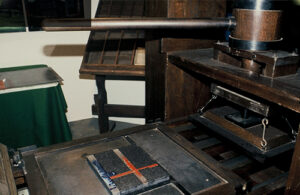Associations and institutions are welcome to apply to become members of the ALCC.
Modern copyright starts with the printing press and follows the invention of new technologies that facilitate the reproduction of content.

The Guttenberg press drastically reduced the time and effort required to reproduce books.
Photo: L J Mohr. CC BY 2.0. Full attribution information below.
To answer the question ‘What is the point of copyright?’ it pays to take a look at it’s history. Copyright is about controlling the unauthorised reproduction of your creative works. But how and why did this idea come about? While digital technologies these days make copying as simple as ‘Ctrl C, Ctrl V’, for much of history it was not that easy.
For most of the Middle Ages copying content was much more difficult. If you wanted a copy of a book, for example, someone would have to copy it by hand – a tedious and time-consuming task. New technologies emerged to increase the ease, efficiency and time at which content could be copied, and copyright has been trying to keep up ever since.
The printing press and the Statute of Anne

The Statute of Anne prohibited unauthorised reproduction of books and was the genesis of modern copyright.
Image: From Wikipedia. Public domain. Full attribution information below.
The contemporary notion of copyright starts with the invention of the Gutenberg printing press. At this time the The Stationers’ Company had exclusive power to print (and censor) literary works in the UK. Despite this copying restrictions the printing press technology drastically reduced the time required to reproduce books and increased the ease at which copies could be made. With the practical barriers gone, for the first time copying could easily occur without permission.
This led to lobbying by The Stationers’ Company and publishers in the guild to curtail the impact of unauthorised copying of books by encouraging licensing of printing of books by authors. In response, on 5 April 1710 the Parliament of Great Britain passed the Statute of Anne, also known as the Copyright Act 1710. It was the first legislative instrument to grant a monopoly right over content – only over books at that time.
The law prescribed a 14-year copyright term, with the option for renewal for a further 14-years. During the copyright term only an author and the printers they licensed their works to could publish copies. After this period the book fell into the public domain. The Statute of Anne remained in force until the Copyright Act 1842 (UK) replaced it.
While the scope of what was protected by the Statute of Anne, and the duration material is protected for, was much narrower than what is protected now, it is the genesis of the modern copyright system.
Copyright and reproduction technologies
This situation may not seem that significant, but it represents a scenario that repeats throughout copyright’s history. As new technologies that facilitate the easy and efficient reproduction of content are invented copyright law reform responds. Examples include:
- The sale of unauthorised piano rolls for playback using player pianos.
- The photocopier and the ability to duplicate entire books.
- Home dubbing of music onto cassette tapes.
- Recording TV shows on VHS tapes, and later set top box digital recorders.
- Burning music and data to rewriteable CDs (CD-Rs).
Phenomena such as peer-to-peer (P2P) file sharing, content snippets on search engines and social media and meme culture are just a few examples of how the internet has arguably become the biggest technological challenge to copyright owners so far, and has resulted in huge shifts in copyright law globally.
